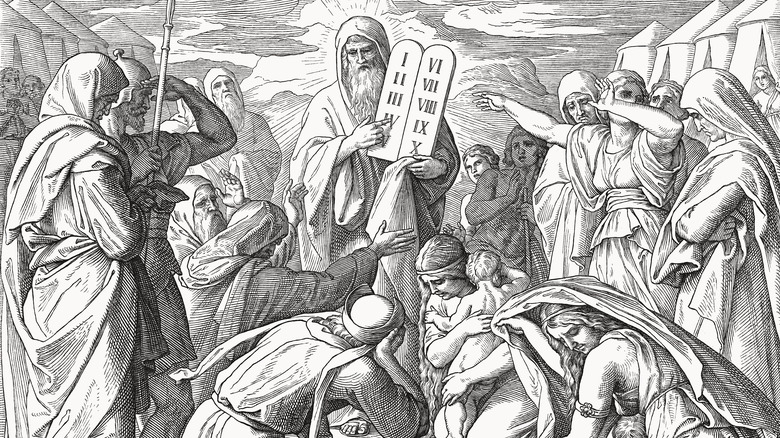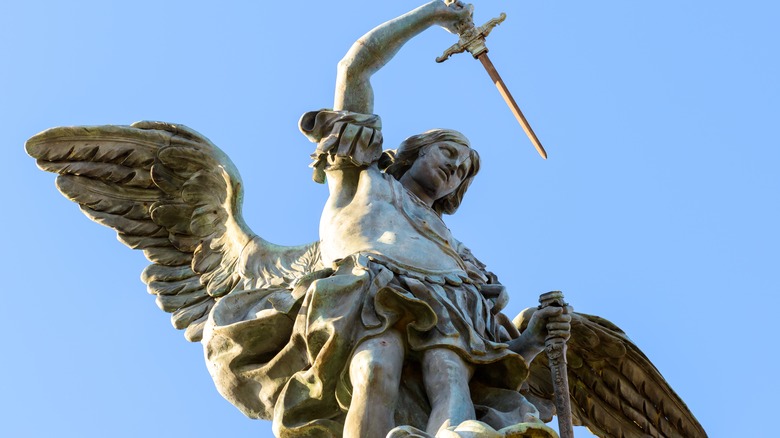What Happened To Moses' Body After He Died?
Without a doubt, Moses is definitely one of the Old Testament Bible's most well-known characters. He's connected to a whole load of prominent, often-cited biblical events like defying Pharoah Ramses II, leading the Hebrews out of slavery in Egypt, parting the Red Sea, retrieving the Ten Commandments, and was played by a grandly-bearded Charlton Heston in that old film epic of the same name, 1956's "The Ten Commandments." Folks with a bit more biblical knowledge might remember his retrieval from a basket in a river as a baby, or an incident like the one when a staff transformed into a snake.
It's not often that the Bible provides grounded, historically helpful biographical information. In Moses' case, however, we do get a bit more info than usual. The Bible does say in Deuteronomy 34 that when Moses died he was buried in a place called Moab, "in the valley opposite Beth Peor, but to this day no one knows where his grave is." He was also apparently 120 years old, "yet his eyes were not weak nor his strength gone."
So Moses was buried and that's the end of it, right? Not quite. There's a very peculiar passage in the New Testament epistle of Jude, chapter 1, verse 9, that references Moses' body. "But even the archangel Michael, when he was disputing with the devil about the body of Moses, did not himself dare to condemn him for slander." Say what? An angel and the devil chit-chatting about Moses' corpse? It seems so, but its meaning remains obscure.
Buried by God in Moab
Before moving forward we should clear up a few disclaimers. First off — and no disrespect meant to believers — we only have religious texts to go on when talking about Moses. There isn't any historical evidence that anyone named Moses actually existed. He's more of a mythical figure who plays a function in the Old Testament plot and whose story mirrors earlier "folk memor[ies]" of peoples in the Levant, as The Washington Post quotes archaeologist Cyprian Broodbank. So when this article talks about what happened to Moses' body, we're talking about what Bible stories say about what happened to Moses' body. Also, when Jude talks about "the devil," bear in mind that "diabolos" — the Greek that gives us our word "devil" — is a common noun meaning "slanderer" and not a specific, hellish entity that any of us moderns would likely envision after centuries of accumulated art and stories.
Bearing all of that in mind, we've got what the aforementioned Bible verses describe happening to Moses' body after he died. Like we said and which Deuteronomy 34 attests, we at least know that his body was apparently buried and not cremated, torn apart in battle, lost at sea, or something else. In fact, depending on the translation, the passage in Deuteronomy says that God Himself buried Moses — "He buried him," with "He" being "the Lord" and "him" being Moses. As for where – the biblical "Moab" refers to the modern nation of Jordan east of the Dead Sea.
Michael and the devil
Things would be simple if the tale of Moses' body ended with his burial in Moab. But, Jude's mention of the discussion between the devil and the archangel Michael about Moses' body asks more questions than it answers. The New Testament letter of Jude, it should be noted, is believed to have been written between 67 and 80 C.E. That's between 600 and 700 years after Deuteronomy was written in the 7th century B.C.E., which itself references much older events. Jude is believed by scholars to be the half-brother of Jesus, but we don't know much about him or what we would have known about ancient Hebrew events. When he references the conversation about Moses' body, he talks about it like it's a common event that his readers already know.
Loads of articles on Christian sites have done their interpretive best to disentangle the passage in question, which isn't mentioned anywhere else in the Bible. Got Questions, in referencing the book of Revelations, suggests that the passage means that the devil protested Moses being granted access to heaven. Compelling Truth says that the passage in Jude might mean that people shouldn't worship things — including the bodies of holy people — rather than God. Finally, the English Standard Version (ESV) online Bible resource says that Jude was written to denounce false church teachers. The cited conversation about Moses — in which Michael doesn't slander the devil directly, but cites God to do so — could just be a convenient choice to make the epistle's point.


